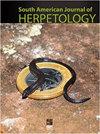确定绿水蟒(Eunectes murinus)的繁殖状况:假设等长的条件指数
IF 0.7
4区 生物学
Q4 ZOOLOGY
引用次数: 1
摘要
摘要资本饲养者是利用繁殖活动前收集的储存能量繁殖的动物。给定个体储存的能量可以通过形态学测量和估计条件指数来量化,这有助于研究野生捕获动物的生殖生物学。几种条件指数已被用于研究蛇的生物学和自然史,其中对数变换数据的残差是最受欢迎的指标之一。在这里,我开发了一个简单的条件指数,假设动物一生中除了条件的变化之外,不会改变形状。这种具有等距假设(CIA)的条件对于所有大小的类都是无偏的,并且计算简单。根据已知繁殖条件的动物的数据,我确定了0.875的临界值。条件较高的动物繁殖的几率较高,而条件较低的动物则没有。该方法正确地预测了94%的观测结果的繁殖状态。使用相同的数据集,我测试了对数变换回归的残差,发现结果要糟糕得多。中情局还能够预测研究中偶然发现的其他蛇的繁殖状况。事实上,可以根据水蟒的状况可靠地预测其繁殖状况,这证实了水蟒是资本饲养者。本文章由计算机程序翻译,如有差异,请以英文原文为准。
Determining Breeding Status in Green Anacondas (Eunectes murinus): A Condition Index Assuming Isometry
Abstract. Capital breeders are animals that breed with the stored energy they have gathered prior to the reproductive event. The amount of energy stored by a given individual can be quantified using morphological measurements and estimating a condition index that can help study the reproductive biology of wild-caught animals. Several condition indices have been used to study the biology and natural history of snakes, with the residual of the log-transformed data being one of the most popular. Here, I develop a simple condition index that assumes that the animals do not change shape throughout life except for changes in condition. This condition with isometry assumption (CIA) is unbiased for all size classes and simple to calculate. With data of animals whose breeding condition was known, I determine a cutoff of 0.875. Animals with a higher condition had a high chance of breeding, while those with lower condition did not. This method correctly predicts the breeding status of 94% of the observations. Using the same data set, I tested the residuals of the log-transformed regression and found far worse results. The CIA was also able to predict breeding status in other snakes opportunistically found in the study. The fact that it is possible to reliably predict the breeding status of anacondas based on their condition confirms that anacondas are capital breeders.
求助全文
通过发布文献求助,成功后即可免费获取论文全文。
去求助
来源期刊
CiteScore
1.50
自引率
0.00%
发文量
10
期刊介绍:
The South American Journal of Herpetology (SAJH) is an international journal published by the Brazilian Society of Herpetology that aims to provide an effective medium of communication for the international herpetological community. SAJH publishes peer-reviewed original contributions on all subjects related to the biology of amphibians and reptiles, including descriptive, comparative, inferential, and experimental studies and taxa from anywhere in the world, as well as theoretical studies that explore principles and methods.

 求助内容:
求助内容: 应助结果提醒方式:
应助结果提醒方式:


